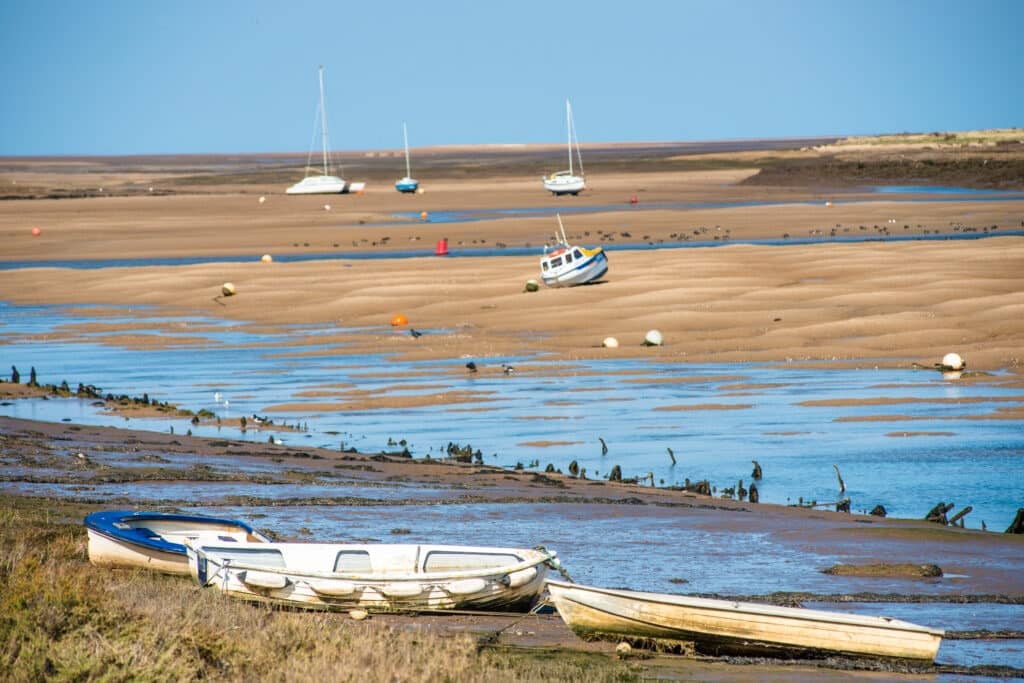
Dawn Flight
It’s bitterly cold. Yet January is an excellent time to head outside and witness one of Britain’s most magnificent dawn experiences. Huddle in the shelter of sand dunes or a Wells beach hut. And wait.
Light glimmers in the east. Day is breaking and with it, an awakening. Ragged cries spike the dark silence. Slowly, quietly it begins. Excitement mounts in rousing crescendos, spreading among thousands of wildfowl, restless on the cold mud.
And then they rise. A wild chorus fills the air, elemental and unrelenting. Thousands of pink footed geese lift almost as one continuous wave of breathtaking joy. Great skeins make V patterns overhead, calling all the while, formations shaping the fading dark. Over the watchers they fly inland, hungry from their night fast, searching for sugar beet tops in newly harvested fields.
In the not too distant past, wildfowlers lined up here, guns loaded to shoot the birds down. Professional wildfowling guides were a cutthroat bunch, guarding their secret shooting locations well. Around this time, Sir Peter Scott, son of the polar explorer Robert Falcon Scott, wrote his book Morning Flight, describing being here as a pilgrimage. His love of such glorious natural spectacle surely informed his work as a conservationist. He established the Wildfowl and Wetlands Trust (WWT) in 1946 and later co-founded the World Wildlife Fund.
And so, morning has come and the geese are off to find breakfast. Time you head back to the warmth of Wells and do the same!

Bird Watching in Stiffkey Wood
The small North Norfolk coastal village of Stiffkey nestles between saltmarsh and deep river valley, reminiscent of Devon. A narrow band of woodland clings to the last vestiges of dry land before the saltmarsh stretches towards the sea. Stunted and aged by winter gales and salty winds the trees are battered, facing northerly lands. They are often the first landfall Norfolk’s world famous bird migrations in Spring and Autumn, when yellow browed warblers, shrikes and firecrests, blow in on winds from the east and north. Other species, like the woodcock, wait until the right moon. Author Henry Williamson lived in the village and wrote about the woodcock’s annual arrival to Stiffkey Wood.
‘It would be pleasant to be a bird-watcher for a year: to wander thoughtless through the calm sequent days of summer’s ending: mist at morning: pallid disc of sun: windless heat and light of pale blue heaven and yellow line of sand dimming to the small red smoulder of sunset: the strings of tired birds, arriving over the sea, and settling at once on the marshes and in the low sand-dunes.
Day after day of windless calm and of sunlight, serene and warm, as though all life were suspended on earth, save for the movement of wave and tide, the piping and passing of birds. The early autumnal days were the most beautiful for that soon the sea would be black, with white lines on shoal and sandbank, while the tractor driver on the hills fastened the sack closer round his waist, against the bitter winds. Soon through the mists would float the woodcock moon, pale and circular; and with the north-east wind would come those strange birds, with dead-leaf mottle plumage and long beaks and gentle brown eyes, flapping across the North Sea, from the forests of Norway, and the stone walls of cold fields above fiords in whose green, glissading depths great salmon moved to their spawning beds.
Soon the wind would arise, and the woodcock flights over the sea begin. Singly and twos and threes, while the moon moved up the sky wind-burnished and bright, with purple shine about its winter beginning, the woodcock would come darkly over the waves.’

Seal Trips with Beans Boats
Across the world communities who live by the sea share legends of seals shifting to human form. And there is something strangely familiar about the gaze of these enchanting creatures from another world.
Operating in all seasons (except during boat maintenance in January and early February) Beans Boats is a family business with over 80 years of getting visitors up close and personal with one of Norfolk’s biggest Grey and Common seal colonies. The residents of Blakeney Point are often lolling about on the beach, calmly eyeing inquisitive humans just as we watch them. It’s important not to disturb them, so a guided boat trip is the best way to learn and make magical memories.
You’ll board one of five custom ferries at Morston Quay, head up Morston Creek and out into Blakeney Harbour. Relax and absorb the Norfolk’s wild beauty from the shelter of the harbour. Blakeney Point is one of Europe’s most important sites for migrating birds, so there’s loads to see on the way to the seal colony. The crew will share local history, passing the old Blakeney lifeboat station towards the tip of Blakeney Point.
Often a curious seal will pop its head from the waves right by the boat, as if checking the crew’s tales hold water! There’ll be plenty of opportunity for asking questions and taking photos, since the skilled crew will get in close without disturbing the seals’ peace. This is their world. It’s a great privilege to be guests here.
Build your own itinerary
If you fancy creating your own itinerary for a day trip to Norfolk or a longer visit, it couldn’t be simpler. Just go to Search Activities and select from our wide range of free and paid-for experiences, saving any that capture your imagination with the click of a button.
Once you’ve finished, you’ll find all the information stored in My Favourite, where you can drag and drop activities to create your own day-by-day itinerary! You can download this to a calendar and even share it with friends.
